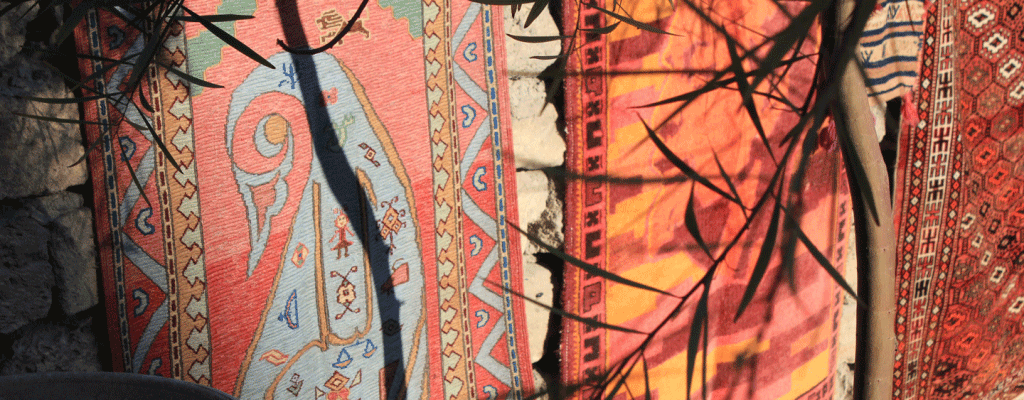
CARPETS
Carpets formed a big part of Azerbaijani historical culture. Interestingly, ancient techniques and types of carpets continue to be integral, artistically and economically, to the country.
Types of Azerbaijani Carpets
Jejim:
Is a kind of pile-less carpet, with its weaving being one of the archaic types. Historically it would take a woman’s labour to produce. Weavers make Jejims to a width of 30-35 cms and length of 15-20 meters. They are machine-made with cotton yarn in narrow horizontal stripes.
Different vertical stripes are normally typical, effective, bright and decorative. However, in many cases weavers adorn the stripes with stylised images of household items. For example: a comb, cotton yarn, and candlestick. They also use geometrical elements. Depending on the colour and quality of the thread of wool, they are smooth, single-coloured or with flower illustrations.
Kilim:
Is also a pileless carpet. Unlike the Jejim, artisans design both the under and top sides of the carpet. They are one of the most common types of carpet that you would see.
Kilim is characterised with ‘crack-like’ light stripes surrounded by geometrical patterns. Patterns usually consist of a rhombus’, triangles and trapeziums according to the technology of Kilim. The composition of weaving in the different zones of the Kilim differs according to patterns and colour. By their technical characteristics Kilims can be divided into 5 basic groups, based on their region of origin and use:
- Gazakh
- Qarabagh
- Absheron
- Shirvan
- Tabriz
Sadda:
Is a carpet also belonging to the pileless family. In most cases, Saddas have chess like quadrangle patterns. The most common pattern type or composition on Saddas was the camel caravan illustration comprising rhythmic horizontal stripes. Sadda has three different methods of processing respectively, these are:
- One-coloured
- Checked
- With a plot
Zili:
Is one of the more unusual kinds of pile-less examples of carpet. Zili carpets manufactured in Barda, Jabrail, Nakhchivan, Shirvan, Absheron, Khyzy, Tabriz, Gazakh and other regions, were exported by merchants to Europe and Russia in XVIII century- early XIX century. Notably, its composition and patterns, Zili carpets of Azerbaijan are very unique. These carpets, like many other Azerbaijani carpets have refined pictures and emotional expressions. However, unique features of their ornamental decoration include big signs such as a large rhombus, a pair of horns, and often stylised elements.
Carpet-making In Historical Context
Artisans developed carpet weaving, most notably during Sasanid’s reign. During this period, people began to weave carpets from silk and golden-silver threads. An Albanian historian, Musa Kalantarsky (VII century) spoke about carpets woven from “silk cloths, and motley carpets”. Carpet making from golden-silver threads and adorned with precious stones had become characteristic of XVI-XVII centuries. However, such pileless carpets called ‘Zarbaf’s’ which were mostly made in Tabriz, Shamakhy and Barda. They were expensive to produce, thus were usually reserved for feudal leaders.
Azerbaijani Symbolism with Carpet Weaving
A Buta is a symbolic ornament depicting a geometric flame, similar to a ’teardrop’ in shape. Tongues of the flame symbolise “The Land of Fire” and are typically depicted in the centre of the emblem. Colours used in the emblem are also colours of the national flag of Azerbaijan. An eight-pointed star symbolises eight branches of Turkic nation.
At the bottom of the emblem is a stalk of wheat and branch of oak. The stalk of wheat symbolises richness and fertility. The branch of oak symbolizes antiquity of the country. A shield in the emblem means defence.
Butas are famed in Eastern countries and found in a broad territory. However they are a typical part of Azerbaijani national ornamentation and Azerbaijani master designers often use Butas. There are many types of Buta and some of them have their own symbolic meanings. Today, this ornament is widely used on carpets, textiles and decoration of buildings. Due to is cultural relevance, many consider the Buta to be a national symbol of Azerbaijan.
For further specific information about the origin and craftsmanship of carpets, please see the links below:

